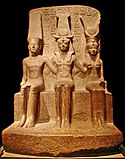The struggle of the nations - Egypt, Syria, and Assyria (1896) (14591710208)
Identifier: struggleofnation00maspuoft (find matches)
Title: The struggle of the nations - Egypt, Syria, and Assyria
Year: 1896 (1890s)
Authors: Maspero, G. (Gaston), 1846-1916
Subjects: History, Ancient Egypt -- History Syria -- History and antiquities Assyria -- History and antiquities
Publisher: London : S.P.C.K.
Contributing Library: Robarts - University of Toronto
Digitizing Sponsor: MSN
View Book Page: Book Viewer
About This Book: Catalog Entry
View All Images: All Images From Book
Click here to view book online to see this illustration in context in a browseable online version of this book.
Text Appearing Before Image:
accompany a Map of the lateRev. F. W. Hollands Journey, in the Quart. Stat., 1884, pp. 4-15). The site of Pakanana has, with much probability, been fixed by Conder (The Fortress of Canaan,in the Quart. Statements, 1883, pp. 175, 176; cf Tomkixs, The Fortress of Canaan, in the Quart.Statements. 1884, pp. 57-61) at El-Kenan or Khurbet-Kauaau, to the south of Hebron. Brugsch hadpreviously taken this name to indicate the country of Canaan (Geographisohe Inschrif ten, vol. i. pp. 59, SETI I. AND THE STUIAX CAMPAIGN OF THE TEAR I. ^tl position on the slope of a rocky liill, close to a small lake, and defended tlieapproaches to the vale of Hebron. It surrendered at the first attack, and byits fall the Egyptians became possessed of one of the richest provinces in thesouthern part of Kharu. This result having been achieved, Seti took thecaravan road to his left, on the further side of Gaza, and pushed forward at fullspeed towards the Hittite frontier. It was probably unprotected by any troops.
Text Appearing After Image:
. t^^Pie^U. JiVt^, lit. i»>.yi,d THE KETDKN OF THE NORTH WALL OF THE HYPOSTTLB HALL AT KARNAK, WHERE SETI I.REPBESENTS SOME EPISODES IN HIS FIRST UAMPAIGN. and the Hittite king was absent in some other part of his empire. Seti pillagedthe Amurru, seized lanuamu and Qodshu by a sudden attack, marched in anoblique direction towards the Mediterranean, forcing the inhabitants of theLebanon to cut timber from their mountains for the additions which he waspremeditating in the temple of the Theban Amon, and finally returned by thecoast road, receiving, as he passed tiirough their territory, the homage ofthe Phoenicians. His entry into Egypt was celebrated by solemn festivities.The nobles, priests, and princes of both south and north hastened to meet himat the bridge of Zalu, and welcomed, with their chants, both the king and 261, vol. ii. p. 51; cf. Lacth, TJeber Sethosit Triumphzu(i, pp. 337, 338), but Chabas rightly cod-teated this view (Voyage dun Egyplien, pp. 112, 113). W. Max Miill
Note About Images
Relevantní obrázky
Relevantní články
19. dynastie19. dynastie je jednou ze staroegyptských královských dynastií řazených egyptology do historického období označovaného jako Nová říše. Vládla přibližně v letech 1292–1191 př. Kr. Počáteční období její vlády kontinuálně navazovalo na dobu Haremhebovu a bylo charakterizováno úspěšným úsilím o překonání důsledků Achnatonovy reformy z doby předchozí 18. dynastie– především dynastické a s ní spojené politické krize a také mocenského konfliktu s Chetitskou říší v Syropalestině. Poslední faraon Haremheb zřejmě neměl potomka a za svého nástupce určil vezíra a generála Paramessu/Ramesse I., který se stal zakladatelem 19. dynastie. Ten upevnil dynastické nástupnictví svým synem – faraonem Sethim I. Po dlouhé vládě Ramesse II. a jeho postaršího nástupce Merenptaha se dynastie dostala do krize, která snad podnítila částečný kolaps politické a společenské stability říše, s nímž se vyrovnal až první panovník následující 20. dynastie Setnacht. .. pokračovat ve čtení
















